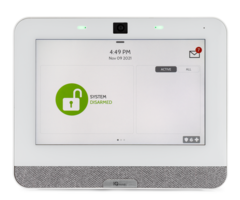Can I Connect The Qolsys IQ Panel 4 To IP Monitoring?
You can connect the Qolsys IQ Panel 4 to WIFI for dual-path communication. But, the Qolsys IQ Panel 4 cannot use WIFI only. It must be registered using the IMEI number of the built-in LTE cellular device. WIFI communication is optional, cellular communication is required for any monitoring.


The Qolsys IQ Panel 4 is a marvel of engineering. It offers a 7" capacitive multi-touch touchscreen, dual-band WIFI, an LTE communicator from either Verizon or AT&T, and support for a variety of RF sensors, depending on the panel version you choose. Every IQ4 supports the 915 MHz PowerG sensors, and there are also versions that support 2GIG and Honeywell sensors, Qolsys and Interlogix 319.5 MHz sensors, and 433 MHz legacy DSC sensors. There's also a budget-friendly PowerG-only 2-1 Kit that is offered only in white. Each of the other "flavors," as we refer to them, can be purchased in white or black.
Alarm.com is the signal transport service that is used by the Qolsys IQ Panel 4. Alarm.com requires that alarm systems that use its service for signal transport do so via a cellular communicator. This is why Alarm Grid doesn't offer our IP-only plans (Bronze and Silver) with Alarm.com service. An IQ Panel 4 cannot be registered with Alarm.com except via its IMEI number. This number ties the panel to an account number, which is how Alarm.com and a central station if used, know which account is reporting an event and where assistance is needed or notifications need to be sent.
Regarding monitoring, Alarm Grid offers two types of plans: Self or Full monitoring. A self-monitored account sends a signal to the signal transport service, in this case, Alarm.com. The Alarm.com server doesn't forward these signals to a central station; instead, it sends a notification to the end-user and any other recipients designated by the account owner. These notifications can be sent via text, email, push notification, or any combination of the three.
A full-monitored account functions the same as a self-monitored one but, in addition to notifying the end-user, it also forwards the signals to a central monitoring station. An operator at the station will receive the signal and process it based on pre-set instructions. This might involve immediate dispatch, a call, or a series of calls to a list of numbers to verify an alarm before emergency dispatch.
Because Alarm.com accounts with Alarm Grid require a Gold Plan (Self or Full) or higher, both self and full-monitored accounts include remote control through the Alarm.com app or website. This remote access allows users to check their system status, arm/disarm the system, verify activity, and, in some cases, view video cameras (with an Alarm Grid Platinum Plan) and control automation devices. For customers seeking basic central station monitored accounts without remote access, we offer our Cellular Alarm Monitoring Plan.
At Alarm Grid, we always recommend using the WIFI capabilities of the Qolsys IQ Panel 4 when possible. Dual-path communication is preferred for those instances where one or the other path is unavailable. Because cellular outages are rare and usually brief, Alarm.com requires a cellular path to be enabled. However, when WIFI is available it is often the fastest path to getting a signal through, so it is worthwhile to set this path up as well.
Alarm.com treats dual-path systems a little differently than AlarmNet with its Total Connect 2.0 service. With Alarm.com, every alarm signal is sent via all available paths. The signal received at the server first is processed, and the "losing" signal is discarded. By handling dual-path signals in this way, they ensure that each individual signal is sent using the fastest available path.
If you are interested in an IP-only system, consider checking out the Resideo PRO Series panels, or any of the other Honeywell or Resideo systems supported by AlarmNet. They will allow an account to be set up using Ethernet or WIFI only, and the price for this type of monitoring is less than the price for cellular monitoring. Just be aware that this type of single-path communication is also less secure than using a dual-path system. With the AlarmNet compatible systems, you could begin with an IP-only system, and add the cellular path at a later time.
Did you find this answer useful?
We offer alarm monitoring as low as $10 / month
Click Here to Learn MoreRelated Products






Related Videos
Related Categories
- Apartment Security Systems
- Home Automation Controllers
- Wireless Touchscreen Alarm Panels
- Small Business Security Systems
- DIY Wireless Security Systems
- Answered
- Answered By
- Julia Ross

